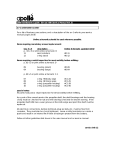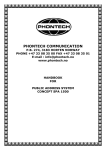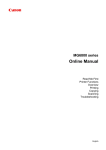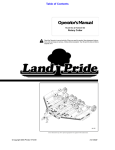Download SAV-7 EVO MANUAL
Transcript
TUSA vehicle SAV-7 instruction manual Introduction Thank you for purchasing an SAV-7. The SAV-7 is revolutionary new underwater vehicle equipped with functions and features that set it apart from previous models and other brands. MAX 6 Variable speed control Quick and smooth speed control is now at your fingertip. Speed adjustments are made via an accelerator button that changes the rotational speed of motor while vehicle is in use. Adjustments are very smooth, allowing user to fine tune speed. These enhancements are a significant improvement on th apollo vehicle series. This new design provides a far more advanced control system than is available on other underwater scooter. 4 2 MIN STOP Hands-free riding with the scooter saddle (PATENT.P) Hands-free is an innovative riding style that allows an operator to steer the scooter with body movement; much like a seal. This inline body placement is more streamlined to effectively decrease fatigue, reduce air consumption, and extend your dive time. Go further, get there faster, and have a lot more fun along the way. The hands-free riding style increases your options while diving. You are no longer limited to the hands-on riding style required by other vehicles. The possibilities are endless. The SAV-7 is not heavy burden The hands-free riding style decreases fatigue, reduces air consumption, and extends your dive time. In the past some divers have become fatigued from the energy and effort required to hold and steer an underwater vehicle. In addition to being a potensial source of fatigue, the traditional hans-on riding style requires the user to place themselves above the vehicle rather than inline. Improvement in transportation options The SAV-7 improves your ability to transport items underwater. Your hands are free to carry what you need. Additionally, fold out wings on both sides of the saddle are available for towing other divers or attaching other items of equipment. The innovative SAV-7 challenges divers to create and find new techniques and methods of use. Go out and enjoy diving with this great new generation diving product. 01 CONTENTS Instruction manual P1 Introduction P2 CONTENTS P3 Before reading the manual P4 Main warnings and notes P5 Specification SAV-7 name of each part P6 Specification Battery (LEAD-ACID battery) exclusive to SAV-7 Charging the battery (in case of LEAD-ACID battery) P7 Preparation P8 Preparation P9 Preparation P10 Preparation P11 Preparation P12 Operation and use P13 Operation and use P14 Maintenance P15 Maintenance P16 Trouble shooting Charging the battery Checking before use (setting) Check before use (confirming operations) Check before use Entry method / Exit How to operate Maintenance after use Note on maintenance and storage The propeller doesn't rotate even through the throttle lever is activated Riding manual P17,P18 For the safety diving P19,P20 STEP 1 Stopping P21,P22 STEP 2 Take off P23,P24 STEP 3 Riding P25 STEP 4 Turning P26 STEP 5 Advanced operations P27 STEP 6 Advanced operations P28 STEP 7 Advanced operations (Carrying) P29 SAV-7 P32 SAV-7 bulkhead Assy P30 SAV-7 saddle Assy P33 SAV-7 body Assy P31 SAV-7 head Assy P34 SAV-7 propeller Assy / SAV-7 battery plug & socket Assy Parts list 02 Before reading the manual Items with the following headings marked with this symbol " " describe scuba diving techniques and how to handle diving equipment. These sections must be completely understood, so be sure to read them with special care. DANGER Failure to read understand and obey the instructions under this heading may lead to accidents that may result in serious injury or death. CAUTION Failure to obey the instructions under this heading may lead indirectly to accidents that result in serious injury, death and or serious damage to equipment. WARNING Failure to obey the instructions under this heading may lead to minor accidents and/or damage to equipment. DANGER It is extremely important that scuba divers using this product have undergone theoretical and practical training given by an internationally-recognized entity providing diving instruction. Due to safety considerations, those who have not obtained a C-Card (attesting to the completion of training) from an entity providing diving instruction must not under any circumstances use this product. (This does not apply to those using this product during training, under the supervision of an instructor attached to an entity providing diving instruction.) Amateurs lacking knowledge of basic scuba diving techniques risk serious injury or death. Never scuba dive alone. Always dive under the buddy system. Diving alone could lead to serious injury and death. Due to the speed of the SAV-7 depth & pressure change may happen faster than usual. The diver must be aware at all times with regards the status of his depth and direction and carefully monitor his ascent rate as rapid surfacing and collisions could cause serious injury or death. Please practice driving at low speed until you become accustomed to the handling of the scooter. CAUTION Make sure you are in good physical condition before you scuba dive. If you begin to feel anxious, cold, tired or unwell, do not over exert yourself and stop your dive. Never take alcohol or medicines (especially a nasal spray or medicine for a cold) before scuba diving. Those who are in poor physical shape or suffer from a chronic ailment should consult a doctor before considering diving. WARING Before deciding to use your scooter in an adverse environment or special situation please consult with a qualified instructor at the place of purchase prior to undertaking your dive. 03 Main warnings and notes CAUTION Please only use our purpose-built battery and purpose-built charger. Otherwise there is a danger of an explosion and fire. CAUTION Please do not change, remodel or disassemble. There are dangers of the explosions and of fire if the electric circuit is tampered with.There are dangers of damage and water leaks in the body and circuits. Please do not touch unnecessarily any moving parts CAUTION (especially the propeller). There is danger of injury. CAUTION Please do not touch the electrodes etc. There is danger of electric shock because of high currents and voltage. Please do not drive the scooter to the surface as there are CAUTION dangers caused by rapid ascent. The rapid pressure decrease associated with a rapid ascent may cause decompression disease or embolism. CAUTION Please only charge the battery in a well-ventilated area and keep it away from an open flame. Hydrogen gas is generated from the battery while charging. There are possibilities of poisoning and fire. Please ensure that string, hose, hair or foreign objects do not become entangled in the propeller. Remove the battery CAUTION before attempting to disentangle any items should the propeller become obstructed. There is a possibility of injury. CAUTION Please do not jump into water with the scooter. The inertia and weight of the scooter is dangerous and could cause injury. CAUTION Please do not throw the scooter from a high place. The inertia and weight of the scooter is dangerous and could cause injury. lease do not enter with the scooter when you are boat diving. CAUTION Have the scooter passed down to you. The inertia and weight of the scooter is dangerous and could cause injury. If your scooter has stopped abnormally or been for repair CAUTION please do not run it for a long distance until after you have confirmed it is safe. An unknown fault or unfinished repair may cause an unexpected accident. WARNING Please execute a thorough check prior to use. An accident may be caused by a malfunction after it enters the water. Please do not run the scooter for more than five seconds out WARNING of water. The seal part on the propeller shaft is damaged by frictional heat, and there is a possibility of water leakage. Please take careful note of your surroundings and WARNING circumstances prior to preparing your equipment on land and in the water. Equipment and materials may be damaged by unexpected operation. WARNING Please disconnect the battery terminal when the scooter is not in use. Unexpected operation due to the switch being accidentally operated may cause an unexpected accident. WARNING Please check the main body o-rings for impurity and dust before usage. There is a possibility of water leakage by imperfect sealing, which may cause damage and an unexpected accident. WARNING Please do not use other than the specified silicon grease lubricant supplied by TUSA. Damage may be caused to the materials the scooter is made from by using lubricants other than what Apollo Sports supply. This in turn may cause an unexpected accident. The above-mentioned table does not mention all prevention matters that could cause danger and injury. Please carefully read and follow the instructions whenever you see the symbol in this book. 04 Specification The SAV-7 name of each part Propeller cover Propeller screen Clamp ring Speed control dial Propeller Assy Propellers Clamp ring lock lever Body Assy Head Assy Locking buckle Wing arms Starter switch Main switch Grips Battery indicator Throttle lever The SAV-7 Specification Saddle Grip Battery plug Water leak sensor terminal Water leak alert lump PATENTED Length and Width : 720 mm x 340 mm Total weight : approx. 18 kg (40 LBS) Weight in the water : 0 kg Speed : 0~4.2 km/h (It depends on the divers posture, physique, and equipment). Active depth : approx 70m Active range : approx 3600m~4000m (By LEAD-ACID battery) : approx 7200m~8000m (By Ni-MH battery) Body : Shock resistant ABS resin Motor : 24V Brushless motor REV reducer : Ring epicyclical gear speed reducer Speed adjuster : Rotational speed control : Variable pitch-type propeller (3 steps) Safety devices : Sensation current shut-down device Thermal switch function automatically shuts down operations when internal temperature rises.Water leakage sensor function turns on warning lamp when water enters the motor or battery housing and automatically shuts down operations. Accessories O ring seals for the main body O ring seal for the propeller end of the body Silicon grease 05 Separately purchased accessories LEAD-ACID Battery (Use only batteries supplied by TUSA) Ni-MH Battery (Use only batteries supplied by TUSA) Charger for LEAD-ACID Battery (Use only the specific charger supplied by TUSA) Charger for Ni-MH Battery (Use only the specific charger supplied by TUSA) CAUTION Please never use other batteries than those supplied by TUSA. (Supplied separately) Please never use other chargers than those supplied by TUSA. (Supplied separately) Battery (LEAD-ACID battery) Exclusive to the SAV-7 Name of each part Grip Battery socket Cd Weight plate Dimension : 125mm x 175mm x 167mm Capacity : 10Ah (DC24V) Chargers (for LEAD-ACID battery) exclusive to the SAV-7 Name of each part AC plug Charging lamp Charger body Charger plug Dimension : 119mm x 73mm x 40.5mm Input voltage : AC90~264V 47~63Hz CAUTION Please refer to the handling manual that is attached to each product explaining the battery and charger used specifically for nickel hydride operation. 06 Preparation Charging the battery (in case of LEAD-ACID battery). CAUTION In this book, it explains only the LEAD-ACID battery as an example. Please refer to the manual attached for each product when you use the NI-MH battery. STEP1 Preparation for charging, Please stand the scooter vertically on the propeller cover. Make sure it's on a flat stable surface so that it cannot fall over and cause damage to the propeller cover and blades. If the scooter is wet, wipe all moisture off completely. STEP2 Unfasten the locking buckles. Unfasten four locking buckles on the body seal. A locking mechanism is attached to the locking buckle to prevent it from releasing as a result of unexpected shocks. First, while pushing the square button in the center of the locking buckle, lift the end of the buckle. Next, after releasing the buckle hook, flip the buckle downward. Release all four parts. PUSH UP STEP3 Removing the battery housing. It may be difficult to remove the battery housing (head Assy) due to negative pressure inside the body caused by contact with the O-ring, temperature variation and other factors. In this case, place the buckle latch under the locking hook and apply pressure with your thumb while pushing upwards. Do this on both sides of the scooter concurrently to break the seal and easily release the battery housing (head Assy). Push the hook with arms. If it is hard to remove head Assy • • • Hook Remove the head Assy. UP Arms WARNING Precautions concerning the handling of the battery housing (head Assy) after removal. Silicon grease has been applied to the seals on the battery housing. Sand and other debris easily stick to this. Be careful to avoid this situation. Water leakage is caused almost entirely by sand or other debris adhering to the seal area. Please put the battery housing (head Assy) in a safe clean place lying down on the ribs located on its base. Please do not place it on sand or on rocks etc. 07 Remove the connector STEP4 Releasing the battery connector plug. Hold and squeeze the release levers on both sides of the battery connector plug and pull upwards. CAUTION Altering the battery connector plug in any way is very dangerous and should not be done. Any alterations will cause unexpected trouble. STEP5 Removal of the battery. Hold the battery firmly with both hands and lift it away from the body. Place in on a clean and dry flat stable surface. Hold the grip WARNING The battery is quite heavy, so be careful not get your fingers pinched or to drop it onto your feet. STEP6 Connecting the single-purpose charger to begin recharging. CAUTION You must use the correct single-purpose charger suitable for the type of battery being used. In this case, we are showing the LEAD-ACID battery as an example. Please refer to the handling manual that is attached to each product about the battery. First, connect the AC (alternating current) plug of the charger to a domestic outlet. Next, connect the DC24V output connector from the battery to the connector receptor plug on the DC24V charger. The charging will automatically start upon connection after the power is turned on at the domestic outlet. CAUTION The connector is polarized, so when connecting, insert in a direction so it will smoothly enter the connector receptor. Charging time of the charger The color of charger lamp will indicate when charging is completed. Charging : Orange light Charging lamp Finished : Green light The orange is gradually changed into green as the charge progresses. A green lamp shows when the battery connector is not connected (open circuit) but the power is on. Charging : Orange Finished : Green STEP7 Disconnect the charger when charging is completed. The battery charger automatically changes into trickle charge mode after charging is complete however please avoid leaving the charger connected after the charge lamp becomes green. At first, turn the power off and remove the AC plug from the domestic outlet. Next, remove the battery connector. STEP8 Charge completion. CAUTION Please do not set the battery into the scooter for at least 30 minutes after completing the charge as the battery continues to emit hydrogen gas. Please keep clear of an open flame. 08 Preparation Checking before use. (setting) STEP1 Set the battery. Put the weight plate under the battery, if it is not necessary to float the SAV-7. The SAV-7 is able to float without weight plate. Please set the fully charged battery in the body housing in the correct position. Set the battery so that the connectors on the body and the battery line up. WARNING Please only use a fully charged battery otherwise damage will be caused. Also check again that the correct charger was used with the correct battery. Next, the battery socket is connected with the body plug. (Please always remove the connector when not in use or during travel to your destination) Water Leak Alert Lamp Connect the socket to right way. At this time, confirm that the warning lamp isn't on. Please do not use the scooter if the warning lamp is on as this may indicate a water leak has occurred PATENTED STEP2 Set the battery housing (head Assy). Please confirm that there is no debris adhering to the O-ring, O-ring groove or O-ring connecting surface. Also confirm that there are no scratches and that an appropriate amount of silicon grease has been used. Check the switch of "Battery Selection Switch" to LEAD-ACID battery. Battery Selection Switch Place the battery housing (head Assy) carefully in position taking note that the ribs on the underneath of the SAV-7 match up. Battery Selection Switch LEAD-ACID NI-MH STEP3 Checking the housing seal. 0.5mm Do not set wrong side! WARNING After setting the housing, confirm that there is a uniform space of about 0.5mm between the battery housing (head Assy) and the motor housing (body Assy). If the space is less than 0.5mm or if the two parts are joined, there is the possibility of the O-ring coming out of the O-ring groove. Confirm that this not the case before proceeding. Check no gap after setting STEP4 Checking the locking buckle. LOCK LOCK Please confirm that all four locking buckles are securely locked. LOCK LOCK 09 Check before use. (confirming operations) STEP1 Turning on the main switch. ON Check your surroundings. Always confirm that nothing can obstruct or become entangled in the propeller. Place the scooter vertically on a level surface. Turn on the main switch. It is located on the right hand grip. STEP2 Checking the battery indicator light. Confirm that all lights are illuminated. (i.e. Green, yellow, and red) Lights the Battery indicator ON About battery indicator It is necessary to synchronize the battery indicator for each type of battery (LEAD-ACID or NI-MH to ensure an accurate display of the remaining battery life. To check the battery life while underwater you must stop driving the scooter, as you cannot get an accurate voltage display while the motor is activated. The display accuracy may be affected by an exhausted battery and ambient temperature. Please refer to the battery indicator as a rough guide only. STEP3 Operate the motor. Push up the throttle lever. Slowly push up and down on the throttle lever. Confirm rotational speed changes are occurring with vertical motion. Also, confirm the sound of propeller for check. Push the throttle lever up and down. MAX 6 4 2 MIN Check the noise Check the battery indicator for battery condition with turning on the motor. Red : empty Yellow Blue : full All colors are tuned on after full charged, then changed color with consumption. MAX 6 4 2 Check the indicator Take all pressure off the throttle lever. Confirm the rotation of the propeller has stopped completely. 10 MIN Preparation STEP4 Turn off the main switch. Move the main switch to off position. Confirm that all battery indicator lights are off. OFF WARNING If switch is left on the standby current will continue to flow. It is possible that damage will occur from over discharge of the battery. Main switch OFF STEP5 Using the variable pitch propeller. Lay the scooter down on a level surface. Pull and turn the pitch control dial knob to make adjustments to the propeller angle. Push the dial back after speed selection. Lay the scooter down on a level surface. Pitch selection Acceleration Maximum speeds Battery consumption =Acceleration purpose PITCH 1 PITCH 2 PITCH 3 (need more power for pulling a heavier person or weight - reduces battery life) =Standard purpose (most efficient setting) =Low speed purpose Confirm that pitch operation moves smoothly through the three stages. The maximum speed of Pitch 2 is as same as Pitch 1. Reach time to maximum speed of Pitch 1 is earlier than Pitch 2. Maximum speed may be different from water current. Pull the pitch dial. Choose the speed level with pulling dial. WARNING Do not miss the check before diving in order to prevent from serious injury. 11 Operation and use Entry method STEP1 Entry from shore. The SAV-7 is very light when in the water - just slightly negative. While hands free riding it's very easy to use the scooter in shallow water even up to waist deep. You don't need to stay on the bottom in shallow water. You can enjoy cruising along the surface quite comfortably until you find a deeper area you would like to dive to. Waist deep • • • Moving along the surface ! or underwater ! CAUTION Never jump into the water with scooter from a boat or any other elevated location. Never throw the scooter, as it is potentially very dangerous. Please refer to the boat entry method for further instruction. Don't throw the scooter. Don't jump from a high place with the scooter. STEP2 Entry from boat and other elevated areas. Please secure the SAV-7 by a lanyard or rope in the water or hand it to the diver after he or she has entered the water. When passing the SAV-7 to a diver already in the water please lower the SAV-7 in so the diver can easily grasp a handle or grip. CAUTION Please turn off the main switch so that the propeller cannot operate by mistake when passing it to a diver. Do not enter from a boat or other elevated position while holding the scooter. boat OFF Do not enter the water while holding the SAV-7. Please turn off the main switch. Exit STEP1 Beach Its recommended to drive the SAV-7up to waist deep water and leave it close to or on the edge the shore. The SAV-7 is heavy when out of water. It is strongly recommended that you remove your diving equipment on the shore prior to lifting the SAV-7. STEP2 Boat Securely attach the SAV-7 with a rope or lanyard to the boat. Lift the SAV-7 from the water after the diver has exited. 12 Operation and use How to operate STEP1 Throttle operation The SAV-7 speed is controlled by the rotational speed of the propeller with the throttle unit and by adjustment of the propellers pitch. The rotational speed of the propeller rises when the throttle lever is pulled up. The rotational speed decreases when the throttle is pushed down. MAX 6 4 2 MIN MAX 6 4 2 Pull out throttle. MIN Push down throttle. Overload protection safty sensor The SAV-7 has a built-in safety device that protects the motor if overloading occurs. For example if rope gets wound around the propeller shaft the scooter will automatically stop. The SAV-7 safety sensor protects the diver's safety from rotation rebound if the propeller becomes entangled or otherwise obstructed. The SAV-7 is equipped with a safety sensor to protect the motor from burn out and deterioration caused by overloading. If the safety device is activated, turn off the main switch once and it will be reset. After resetting, the motor should works as usual. CAUTION If the motor has stopped please carefully check for debris that may be obstructing or entangled in the propeller area. Please ensure the debris is completely cleared away prior to resetting and reactivating the motor otherwise damage may occur. 13 Maintenance Maintenance after use. Please wash with tap water after use. Make sure to flush sand and other debris from around the propeller, switch, throttle unit, and locking buckles. STEP1 Avoid salt build-up - desalt afte use. Stand the SAV-7 upright, and flush with tap water from your hose all salt, sand and debris. Take special care to efficiently wash the switch part of the throttle unit, as this is a critical moving part during operation. With the SAV-7 laid horizontally slowly rotate the propeller manually and wash using a hose all the joints and seam in and around this area. If possible, you can "desalt" the SAV-7 in a large water tank if the diving store has this facility. CAUTION Please do not activate the SAV-7 until confirming that the surrounding area is safe and that no other equipment is in the tank as the propeller generates turbulence. Please never put your hand near or in the rotating propeller. 60 A water tank that has not been refreshed may itself have excess salt and in this case will not provide a sufficient rinse. STEP2 Disassembling the propeller Assy. CAUTION Please remove the battery from the SAV-7 before working on the propeller area. Pull up the two clamp lock levers in order to unlock the clamp ring. Next, the clamp ring can be unlocked by rotating counter clockwise and matching the oval mark on the clutch/propeller housing. Pull clamp lock lever toward self Then pull out the propeller housing. And turn clamp ring. Remove propeller Assy. STEP3 Check and cleaning of propeller Assy. Check to see if any water leakage has occurred inside the propeller Assy. If a little water is present please flush it away with fresh tap water. WARNING A small amount of water leakage (a teaspoon or so) is not abnormal and will not harm the operation of the SAV-7. However, if the propeller Assy is full of water then discontinue using the SAV-7 as the propeller Assy area and rear seals of the SAV-7 need to be overhauled before any further use. In general many scooters have leakage weakness around the sealing area on the propeller shaft. If a seal becomes worn water can infiltrate the motor compartment and cause major damage. SAV-7 have greatly improved this area of weakness in comparison to other scooters. We specially designed a double sealing system for the propeller shaft by building a small watertight compartment between the first seal and the second seal. Even if water leaks into this area through Propeller Assy the first seal into this compartment further leakage into the motor compartment is prevented.(PATENTED) STEP4 Set the propeller Assy. Please drain all water completely. Please check the O-ring, O-ring groove, and O-ring surface and remove any dust, sand or debris. Check for any scratches or damage to the O-rings and confirm an appropriate amount of silicon has been applied. Installation of propeller Assy is the inverse order to "Remove the propeller Assy". Please note that the propeller shaft needs to be seated correctly before pushing the propeller assembly down and relocking the clamp ring into position. You can find the right position by pushing down gently on the propeller Assy while slowly spinning the propeller manually. Please confirm the clamp ring is seated down correctly and that the O-ring is not protruding. 14 Maintenance Note on Maintenance and Storage STEP1 The main sealing O-rings. There are four main sealing O-rings. Two large O-rings between the top cover (head Assy) and body Assy, and two smaller ones between the body Assy and propeller Assy. You must replace these O-rings if they are in any way damaged, deformed, or creased. We highly recommend that these O-rings be changed annually. Please use an O-ring pick made of soft plastic when removing the O-ring from the groove. Please never use a screwdriver or a sharp tool. O-rings for Propeller Assy O-rings for body CAUTION The grease used for lubrication of the O-rings must be the silicon grease specified by TUSA. Other types of grease can cause the plastic in the housing to split and for O-rings to expand which may cause serious leakage to occur. Please note that the damage caused by the use of grease other than that specified by TUSA will void any warranty. STEP2 Body Impact absorbent acrylonitrile-butadiene-styrene resin is used for the body of the SAV-7. This material excels in strength and durability, and looks great after years of service. However, the material may be seriously compromised and damaged if you use the wrong lubricants and or cleaners. Please note the following. CAUTION Please never use organic solvents such as gasoline, oil, petroleum, grease (Vaseline included), alcohol, the toluene, methyl, ethyl, ketones, and acetones nor strong detergents, etc. STEP3 Throttle unit Please execute "Desalt" process on all moving parts. Especially the throttle lever. STEP4 Storage notice Please disconnect the plug from the battery during storage. Please keep the box the SAV-7 is delivered in. This box will help prevent damage during transport. r ote co -7 s SAV Remove the battery socket. Please keep the package. 15 Trouble shooting Symptoms : The propeller doesn't rotate even though the throttle lever is activated. Check1 : The SAV-7 won't activate. Please confirm the battery indicator lights are on. Action when trouble is found. Please turn the main switch on. ON Please go to the following step if the scooter still does not operate. Check2 : The battery may not be connected correctly. Please open the SAV-7 head and confirm that the battery lead is not connected. Action when trouble is found. Please connect the battery connector correctly. Please go to the following step if the battery is connected correctly. Check3 : Can you push the red throttle unit switch button on the side of the SAV-7 main body down firmly? Visually confirm the operation of the switch. 4 2 6 MIN Action when trouble is found. Normal operation can be expected after repair. Please request your local dealer to repair the scooter if you do not understand the repair method. Please go to the following step if the throttle seems to be working correctly. Check4 : Is the battery charged? Please remove the battery and try another completely charged battery. Action when trouble is found. Please recharge your existing battery and try again. If the symptom still persists after another fully charged battery has been tried then please go to the next step. Check5 : The water sensor may have been activated Please open the head Assy cover, and confirm the warning lamp is on. Action when trouble is found. Please dry around two sensor screws that are located on the top of the bulkhead. If the warning lamp has not turned off, or the warning lamp lights up frequently, the SAV-7 may be leaking. Please request a full overhaul with your dealer. Water leak alert lamp Water leak sensor terminal Please go to the following step if this sequence of troubleshooting doesn't correspond. Please advice the dealer that the SAV-7 is not operating even after all the above points were addressed and checked. 16 Riding manual For the safety diving Clearing ears. Ears are cleared in the same way as for regular diving. However, the speed will cause water pressure changes faster. Therefore, ears must be cleared faster and more frequently than usual. As the diver's face is often turned upward when in a riding position, it is best to draw the chin back when clearing the ears in order make the auditory canal open up more easily. Buoyancy adjustment. Because the rider's hands are freed up during hands-free riding, he is able to operate the inflator and exhaust valve as he normally would. Because the body is horizontal when riding the SAV-7, its position can be kept stable by discharging air using the exhaust valves located at the shoulders or hips. Using fins as a stabilizer. During hands-free riding, fins are used as stabilizers. The diver should try to keep the fins positioned near the center of the propeller cover during regular or highspeed runs, keeping fins even with the propeller shaft of the SAV-7. The water current created by the propeller will hit the fins. This will help counter the force that pushes the scooter to rotate in a counterclockwise direction (rotation torque). When running at a slow speed, the upper body will lift slightly, causing the knees to lightly bend. In this case, the diver must try to keep the fins horizontal to the propulsion direction, so that, here too, they can act as a stabilizer. DANGER Never scuba dive alone. Always dive under the buddy system. Diving alone could lead to serious injury and death. Due to the speed of the SAV-7 depth & pressure change may happen faster than usual. The diver must be aware at all times with regards the status of his depth and direction and carefully monitor his ascent rate as rapid surfacing and collisions could cause serious injury or death. Please practice driving at low speed until you become accustomed to the handling of the scooter. There are screen on the propeller cover for preventing from entangling wire and seaweeds. However, do not dive with the SAV-7 at the seaweed area. Characteristics of the Apollo the SAV-7 scooter Speed control The SAV-7 is a multipurpose underwater scooter equipped with an innovative "throttle-based gearless drive mechanism." Shifting gears while running. On former underwater scooters, the gears could only be shifted by manually changing the pitch of the propeller while the scooter was in a stationary position. Having to stop each time to change the speed was difficult and inconvenient. To overcome this problem, the SAV-7 is now equipped with a mechanism that changes the revolution speed of the motor. Now the gears can be shifted while running, eliminating the need to stop each time. The mechanism that changes the motor's revolution speed has made "gearless" speed change possible. Speed is no longer changed in phases by manual adjustment of the propellers pitch. Propeller pitch conversion mechanizm. The SAV-7 is also equipped with a propeller pitch conversion mechanism. Note The speed for Pitch 1 and Pitch 2 are approximately the same. Pitch 1 has a higher acceleration rate, and therefore top speed can be reached slightly quicker compared to Pitch 2. Minimal difference in the top speed of Pitch 1 and Pitch 2 can be observed when the optimal level of propulsion resistance is reached. 17 Scooter saddle Handle The handles on either side of SAV-7 are handgrips to hold onto. They are an important part of the scooter that are used in many situations including take off, stopping, and turns. The handgrips should not be used to carry the scooter on land. Saddle To minimize underwater resistance and to allow for effortless underwater maneuvering, the SAV-7 is designed to be steered hands-free. In doing so, the saddle helps to hold the diver in place, and allows the diver to steer the scooter freely. Even relatively sharp turns are made possible when riding hands free. Throttle lever The throttle lever functions the same way as the gas pedal on an automobile. The revolution speed goes up when pushed down, and goes down as the lever returns to its original position. Wing arms Wing arms are used on the SAV-7 for triple (three-person) rides. The grips are used to pull the two guest divers. By attaching a karabiner onto the hole in the wing arms, they can also be used to carry underwater equipment. To loosen the knobs, the wing arms are pulled out. Knob Hold the grip with both hands. Do not carry by one hand. WARNING Do not carry the SAV-7 by one hand on the shore. Hands-free riding. (PATENT.P) Hands-free riding is a new riding style in which the diver uses his body instead of his hands to steer the scooter. This frees up the diver's hands. Different from past scooters that were steered using both hands, the diver steers the SAV-7 using his entire body. This greatly reduces the amount of physical strain put on the diver. It allows for "long-distance travel" and "extended diving time," enabling the diver to explore greater distances and diving environments that may have been impossible in the past. There are great benefits to being able to drive hands-free. Scooters that need to be steered by hand end up becoming like a piece of baggage itself underwater. Divers who thought, "Using a scooter keeps me from being able to carry anything else underwater," will now be free to take what ever they want on their dive. Because different items of underwater equipment can be attached to the scooter using the wing arms, the carrying capabilities are vastly improved. Long-distance travel is made possible. The SAV-7 can travel underwater distances of around 3,600 to 4,000 meters when a LEAD-ACID battery is used. Since it takes over one hour to cover 4,000 meters when traveling nonstop, a diver can easily travel continuously over the time span of a regular single dive. For leisure diving, in which the diver uses the scooter only to travel between certain diving spots, it can easily run for two dives. CAUTION Battery duration may vary depending on how it has been stored or used. Do not use a battery that is old or fully discharged, as its power could suddenly drop, or it could have an extremely short running time. 18 STEP1 1 Positioning for hands-free riding. The diver positions the SAV-7 between the legs so the scooters propeller shaft and the axis of the diver's body are lined up. As the SAV-7 moves forward, the body will naturally be pushed from behind. The diver does not need to grip or force himself to sit on the SAV-7. Just wait as the SAV-7 will naturally push the body. Good posture: pushed by the SAV-7 Bad posture: the diver and the SAV-7 will not be able to move as one, which will throw the diver off balance and prevent a smooth takeoff. 2 Stopping The point to be cautious of when stopping is adjusting your balance when there is no longer any forward-moving force.Without momentum, the diver's body will become unsteady. You must adjust and attain your balance. If there is no place to land, you may need to adjust your buoyancy. Landing 4 2 6 MIN Stop the propeller by lowering the throttle lever. Using the same hand that moved the throttle lever, take hold of the grip on the saddle unit. Hold the scooter with your hand and also grip it between your knees. Push throttle lever down. Hold the SAV-7 with your hand. Grip the SAV-7 between your knees. WARNING In the case of dry suit diving, please pay attention of air volume in the suits. It is possible to blow the air from the suit or sudden surfacing. Please put the air in the suit shorter than usual for diving with the SAV-7. After the SAV-7 stops, and while maintaining left and right balance, allow the weight of the SAV-7 to move the body to an upright position. Land on the ground in a standing position. Once the feet touch the ground, 19 Remove the scooter. Moving to hovering mode. MIN 6 4 Adjust buoyancy. 2 2 4 6 MIN Reduce speed by shifting the throttle lever to the low-speed position. Once the speed is reduced and the weight of the SAV-7 can be felt, adjust buoyancy. Turn to minimum speed. Turn to Pitch4 or 5. Using the same hand that moved the throttle lever, take hold of the grip on the saddle unit. Hold the SAV-7 with your hand and also grip it between your knees. Hold the SAV-7 with your hand. Grip the SAV-7 between your knees. After the SAV-7 stops, maintain left and right balance and go into hovering mode. Do this by adjusting buoyancy once again while allowing the weight of the scooter to bring the body into an upright position. Rise with scooter's weight. Adjust buoyancy. Bring the body into an upright position. Repeating steps 1 and 2 will reduce the amount of buoyancy shift that occurs at the point in which the SAV-7 reaches a complete stop, making for easier maneuvering. 20 STEP2 3 Take off Learning to be pushed by the SAV-7. The key to successful takeoff is to learn to be pushed by the SAV-7. If the diver is too eager to move forward, the diver and the scooter will not be able to move as one, which will throw the diver off balance and prevent a smooth takeoff. Counter balancing the rotation torque. Right after takeoff, the diver will feel the SAV-7 rotate in a counterclockwise motion relative its forward movement. This is due to the rotation torque of the propeller. As a way of countering this movement, the diver can twist his upper body to the right. Another simple technique is for the diver to imagine taking off in the direction of "11:00 (forward to the left)." This will naturally twist the diver's body to the right, which will reduce the effect of the rotation torque. Once a stable forward motion is achieved, the rotation torque will become weaker. Preventing sand disturbance. The water current caused by the propeller is more far-reaching than one might imagine. At take off, the diver must be aware of what is behind him, so as not to hit other divers with a slipstream coming from the propeller. Taking off from a landing position will disturb the sand underneath. Kick to move slightly off the seabed and sufficiently tilt forward before turning on the propeller. Taking off from a landing position Hold the SAV-7 in an upright position on the seabed. Approach the SAV-7 from behind, and position the body above the saddle of the throttle unit. Approach the SAV-7. Upright position. Pull the SAV-7 up to a riding position by taking hold of the handle of the saddle unit. Firmly grip with the knees to hold the SAV-7. Grip with the knees to hold the SAV-7. Up to a riding position. From there, lean forward, and kick off the seabed in order to avoid disturbing the sand. Taking off from a landing position will disturb the sand underneath. Kick to move slightly off the seabed and sufficiently tilt forward before turning on the propeller. Lean forward. Kick off the seabed. 21 MIN 6 4 2 MAX After moving away from the seabed with the entire body tilted forward to around a 45-degree angle, pull the throttle lever for takeoff. Taking off from a hovering position. Take hold of the throttle unit and bring the scooter directly below the body. Pull the SAV-7 up to a riding position. Bring the SAV-7 directly below the body Pull the SAV-7 up. Start the SAV-7 at slow-speed by pulling the throttle lever slightly. The SAV-7 itself will move toward the body, eliminating any sense of instability. Be careful not to be pushed suddenly upward by the SAV-7. MIN 6 4 2 MAX Be careful not to be pushed suddenly upward ! Start the SAV-7 at slow-speed. While adjusting the body to reach a horizontal position, gradually build up speed and take off. Once stabilized, the key is to make your buoyancy slightly negative, or to descend in the water to create negative buoyancy. Create negative buoyancy. The body to reach a horizontal position 22 STEP3 Riding Surface riding Riding at the water's surface is also possible with the SAV-7. By wearing equipment designed for skindiving (mask, snorkel, and fins, and appropriate amount of weight on the hips), the diver can easily move around the water's surface. Normal riding Back riding Head first riding Pay attention of clearing ears ! Slow speed riding (propeller pitch = 2 or 3 ; throttle position = 4 - 6) The force of negative buoyancy The power generated by the scooter Direction Diver's negative buoyancy Upturn. When riding at slow-speed, it is necessary to adjust your buoyancy slightly using a buoyancy compensator (BC). In doing so, the diver's legs will sink due to the weight of the SAV-7, making the upper body rises up slightly. In order to balance out the upward force caused by the lowering of the scooter and the diver's negative buoyancy, the revolution speed of the propeller and the angle of the scooter must be adjusted. Speed up. Making turns using the body to help steer is not as effective when riding at low-speed. To make a left or right turn, lean the upper body while in an up upright angle / position in the direction of the turn, and the SAV-7 itself will begin to move in that direction. 23 Normal-speed riding (propeller pitch = 2 ; throttle position = 5 - 7) There is increased stability in the forward motion when riding at a normal speed, and therefore, the SAV-7 will not sink even when there is a certain level of negative buoyancy. Because the diver's entire body is being hit with an appropriate amount of water current, using the body as a rudder for steering and hands as breaks is very effective thus providing a high level of freedom in underwater movement. Therefore, when riding in an area where water depths vary, buoyancy that is perfectly neutral can actually prove to be a hindrance. However, in traveling long distances through water with constant depth, it is better to attain neutral buoyancy, since this will improve battery efficiency and make it easier for the diver to stay underwater. Prease refer to Page 25 for more explanation. Under normal speed, the diver can make left or right turns easily by using the body as a rudder for steering and the hands as breaks. The rider must try to maintain directional control while moving forward by bending your body at the waist towards the target or direction you intend to travel. High-speed riding (propeller pitch = 1 or 2 ; throttle position = 6 - 8) MIN 6 4 2 MAX Similarly, in high-speed riding, having slightly negative buoyancy will make it easier to maintain control. Riding form is very important for high-speed riding. The diver should be aware of the surrounding water current, and keep the frontal body area as low profile as possible. Also, the diver should try to reduce drag and may obtain increased speed by holding one fist out in front of the body. Good posture of high-speed riding At high speed, the difference between Pitch 1 and Pitch 2 is very subtle. At Pitch 1, the maximum level of efficiency cannot be achieved unless the divers equipment is low profile and body posture is good. The turning radius becomes larger at high speed, and therefore the rider must be careful of obstacles. 24 STEP4 Turning Steering with your Body. (Using your upper body as a rudder) The diver's entire body, from the top of his head to the tips of his fins, is used as a rudder. It is especially effective to use the upper body, as you will be propelled in the direction to which your body is bent. Open turn The diver arches his body back while thrusting his chest forward. The scooter will curve toward the diver's back in a large circular motion. With open turns the diver feels safe because he is able to see where he is going while turning. Closed turn The diver bends forward at his stomach. This allows for a sharp turn. However, it is difficult for the diver to see where he is going, or judge the depth of water. This turn is also used to go into a drift mode. Compulsive turn Turn with holding the grip and move the SAV-7 by grip compulsively for adjustment of turn. This way makes smoother like car driving during turn. Hand brake The diver creates resistance on either side of him by "holding the palm of a hand against the water current," or " holding an arm away from the body. " This will reduce the speed on the side that the resistance is created, causing the SAV-7 to veer toward that direction. This technique is used to make slight adjustments in the direction to which the scooter is already moving. Holding an arm away from the body. Open both arms for reduce the speed. 25 STEP5 Advanced operations Drifting A resistant brake using his upper body in the same manner as with a closed turn Running at high speed. Gradually adjusts the position... The diver enters a turning point without slowing down and applies a resistant brake using his upper body in the same manner as with a closed turn. Once the diver's head is turned to the desired direction, he slowly extends his body and gradually adjusts the position of the scooter to face that direction. When doing this, he should slide his upper body sideways to gradually move toward the traveling direction. Because this technique allows the diver to determine which way he is going soon after entering a turn, it is useful for situations in which the diver suddenly sees a target to aim toward. Hairpin 4 2 6 MIN This is a technique in which the throttle is briefly shut off before or during a turn, allowing the diver to drastically reduce the radius of a turn. It is used when the diver needs to change directions on the spot, much like making a flip turn in swimming. In the same manner as making a closed turn, the diver turns his body at a slight angle and applies the brakes using upper body resistance. Once the body begins turning, the throttle is shut off, reducing the propulsive force of the SAV-7 to zero for a time. While using the momentum to change the direction of the scooter, the diver shifts his upper body to face the desired direction and then stretches his body in that direction. After the SAV-7 has changed directions, the diver switches the throttle back on to start up again. 26 MIN 6 4 2 MAX Using the momentum to change the direction of the SAV-7. STEP6 Advanced operations Tandem (two-person ride) The pilot diver boards the SAV-7 at the regular position. The guest diver takes hold of the grip located on the backside of the SAV-7. In doing so, it is not necessary to hold on tightly. It is enough to hook on a few fingers. If the guest diver holds the grip too tightly, he will constrain the movement of the SAV-7, making it difficult for the pilot diver to steer. Hold of the grip located on the backside of the SAV-7 Grip Triple (three-person ride) The pilot diver boards the SAV-7 at the regular position. The two guest divers open and grip the wing arms of the saddle. The guest divers should position themselves underneath and horizontal to the pilot diver. This will stabilize the overall movement. As for left and right positioning, the guest divers should try to stay in the water current created by the pilot diver. Such positioning will keep the propulsion resistance from increasing drastically, allowing for faster travel. Wing arm Grip the wing arms Train (riding with four or more persons) Four or more people can ride together by linking up vertically like a train. The pilot diver starts the SAV-7 at low speed. The first guest diver takes hold of the pilot diver's ankles. As soon as the first guest diver attaches himself, the pilot diver increases the speed to stabilize the overall balance. When the pilot diver pulls the throttle, the scooter will not speed up right away. While waiting for the speed to increase, the third and forth divers take hold of ankles of the diver in front of them. The SAV-7 has enough power to pull five to six people, but having that many will make certain maneuvers such as turning difficult. It will obviously slow the speed down, and making sharp turns will be impossible. Riding with many divers should be seen not as a mode of transportation, but as a form of recreation. Hold both ankles of the front diver. 27 STEP7 Advanced operations (Carrying) The wing arms of the SAV-7 are used to carry underwater equipment. The diver opens both the left and right wing arms of the throttle unit. Karabiners attached to any equipment you want to carry are hooked onto the holes in the wing arms. Distribution of underwater weight. As a general rule, the underwater weight of equipment that is attached to the wing arms should be evenly balanced between the left and right sides. When it is not possible to distribute the weight evenly, it is best to attach the load that is slightly heavier onto the right wing arm, since the rotation torque turns toward the left (counterclockwise) relative to the direction in which the SAV-7 is traveling. Underwater resistance. The diver must take into consideration not only the underwater weight of an object being towed, but also the underwater resistance. When an object that causes great resistance is towed underwater and is attached to just one side of the SAV-7, it could throw the SAV-7 off balance when moving forward. WARNING Equipment that could get caught in the propeller is not suitable for carrying. Practice keeping attached equipment as close as possible to the SAV-7 body otherwise your ability to turn and take off effectively may be reduced. The wing arms are designed to sustain underwater weight. Equipment that is able to be carried underwater could damage the wing arms if it is brought on land while still attached. Therefore, remove the equipment from the wing arms before bringing the SAV-7 out of the water. Wing arm Snap rings are useful . Carrying Those ways are just one of idea for riding SAV-7. We hope you create new idea of riding SAV-7. There are more idea of riding way unlimitedly. 28












































